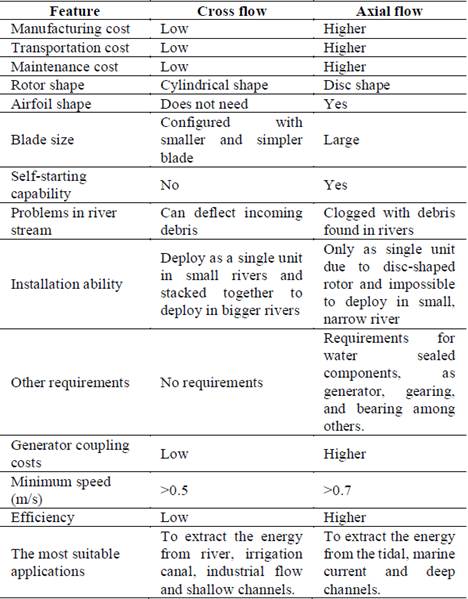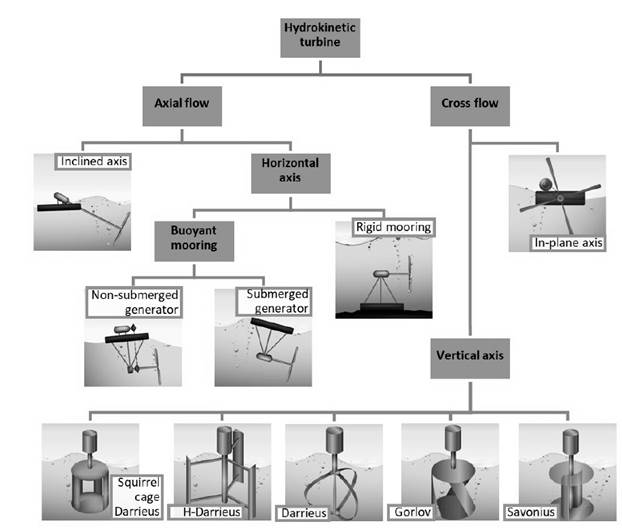1. Introduction
The increasing energy demand and the ongoing transition from fossil fuel hegemony to multi-energy supply [1], the non-access to an electric power grid of some regions and the harmful environmental effects have motivated the search for new alternative energy sources [2]. In this regard, the renewable energies emerge as sources of clean and regenerative energy that could improve the energetic security and reduce the greenhouse gases emission [3,4], as is the hydropower energy. Moreover, in rural communities with a widely access to the rivers, hydropower energy has been considered the best energy source option for producing electricity [4].
Two approaches to obtain electric energy from the water can be differentiated: the hydrostatic energy and the hydrokinetic energy. In the hydrostatic energy, the water is stored in reservoirs in order to create a pressure head and to obtain the potential energy of water. On the other hand, the hydrokinetic energy is obtained by using of the streams of rivers with suitable speed values [4].
In general, the hydrostatic sources have environmental problems and high social impacts, therefore, this type of energy is considered as non-renewable source by some researchers and organizations. On the other hand, hydrokinetic energy is still considered as a renewable energy source, since this type of plants does not cause problems such as resettlement of populations, deforestation and its environmental impact is low [4,5]. Although this technology has some technical disadvantages, such as the relatively small production, the high sensitivity of the energetic supply to variations of the seasons, the cavitation problems in turbines and the block of navigation and fishing in rivers that can be generated by the installation of turbines, the following advantages promote the research and implementation of this technology [4,6]:
The hydrokinetic energy presents greater possibility of extracting power than wind energy, even a low speeds of river in comparison with low speeds of the wind, given that the water is 800 times denser than the wind [4,6].
The provision of electrification in regions close to rivers, where the construction of dams is unviable due to the irregularities on the topography and geology, is possible with the hydrokinetic energy [4,6].
The natural conformation of region is not seriously affected by the presence of hydrokinetic systems [4,6].
These advantages have increased the use of hydrokinetic energy in order to attend the energetic demands in rural sites where there is no access to electric power grid and that present a high dependency on fossil fuels as diesel, gasoline and LPG (Liquefied Petroleum Gas) among others [6]. In this work, a review about applications, challenges and achievements of the application of hydrokinetic energy in different countries and the potential applications and advances for the Colombian Case is presented.
This paper is divided in four sections. The second section introduces the main technological and social aspects for this technology, in the third one, presents an overview about studies, applications and advances of the hydropower energy in the world context. Finally, the section four presents the general conclusions.
2. Technological and social aspects of the hydrokinetic energy
The available hydrokinetic power is function of the speed, the depth and the flow of the river. In following, some features for the operation of hydrokinetic turbines are presented:
The minimum current required to operate is around 0.5-2 m/s, based on the type of device selected. The optimum currents are found in a range of 1.5-3.5 m/s [6].
The water depth is an important factor in the total energy that can be extracted from a site, since the cross-section area over which a turbine can extract energy is dependent on suitable water level above the installed device [7].
The ideal installation locations for hydrokinetic devices are in sites where the rivers has more or less steady flow throughout the year and that are not prone to serious flood events, turbulence, or extended periods of low water level or droughts [7].
In several publications, the technical features and performance of the hydrokinetic turbines are described [6,8-15]. In this work, the 2 most common arrangement of small-scale hydrokinetic turbines are treated, where they are classified according to the turbine types and axis alignment of rotor with respect to the water flow (see Table 1 and Fig. 1):
Axial flow turbine: this configuration is also called horizontal axis, here the turbine has a rotor axis parallel to the incoming water stream.
Cross flow turbine: this configuration can be divided in vertical axis and in-plan axis, where the rotor axis is vertical and parallel to the water surface, respectively, but orthogonal to the incoming water stream.
Table 1 Comparison between cross and axial flow hydrokinetic turbines [6,11,13,16,17]

Source: Elaborated by the authors
The impact of turbine operation on the aquatic environment is one of the most important aspects that will determine the development and the intervention of the different agencies whether private or governmental toward implementation of this new technology. In this order of ideas, this technology has several challenges that must be overcome such as the effect caused in the turbine operation by debris, sediments and the instability of the rivers in terms of turbulence, current, and velocity and the effect of the turbine operation on fish and marine mammals and their habitat [7].In social terms, small scale hydropower is one of the most economical and environmentally friendly technologies to be considered for rural electrification projects, since this technology does not have the high cost associated to the installation of the grid extension and it avoids the need of the use of fossil fuels. On the other hand, Hydrokinetic energy can be complemented to a solar energy, and it produces electricity for 24h a day as long as the running water is available and it is a much more concentrated energy resource than either wind or solar power [6]. However, the challenges that inhibin the development of this technology are associated to the lack of research demonstrating the technical, economic, and environmental benefits. It is necessary to implement about techno-economic analysis that include the cost of capital, maintenance and operation [6].
3. Overview about studies, applications and advances of the hydrokinetic energy in the world
The evaluated articles are presented in Table 2, listed in alphabetical order by country name and in chronological order for each country, along with a short summary of the study and results. The reviewed case studies can be categorized into 3 groups:
Studies where the assessment of the theoretical hydrokinetic power and the potential use of hydrokinetic turbines in a particular river is carried out. These types of studies are usually done through analytical or numerical simulations that are based on key hydrological, hydraulic, geometric parameters and technical data of the equipment, which are obtained from historical data, field visits and manufacturer's data sheet.
Studies with experimental tests and performance evaluation that were conducted at a particular point of a specific river, obtaining in this way, the efficiency and the main problems that arise during the installation and operation of a hydrokinetic turbine.
Research works that, considering the rivers characteristics of the specific region, gives rise to the design, numerical modeling, optimization and construction of hydrokinetic turbines prototypes using human talent, technology and local physical resources.
4. Conclusions
It is clear the world interest in taking advantage of all the energy potential that many countries have at river and marine level, even more so with the constantly growing demand for energy and especially clean energy in accordance with the policies and purposes oriented by The Sustainable Development Goals (SDGs), in addition to the immersed benefits in economic and social development.
Although years ago, hydrokinetic generation in rivers was not considered a feasible option to implement in off-grid power generation, in the last decade interest in this technology has given rise to intense exploration around the world, with initiatives to evaluate and adjust the technical and economic aspects to an adequate adoption, seeking to satisfy, first and foremost, the needs of isolated communities. The challenges inhibiting its development have been associated with the lack of previous research demonstrating the technical, economic and environmental benefits, what can be achieved through the implementation of techno-economic analyses that include the cost of capital, the definition of the most suitable location for installation, maintenance and operation.
An interesting alternative that can be considered as a pilot of hydrokinetic projects is the deployment of turbines for power generation downstream of hydropower plants. Several initiatives in this regard have been reported, including Brazil and a first initiative in Colombia in 2016 [21] in a pre-feasibility stage, showing that it requires further development and studies for optimal benefit.
In Colombia, very little research and development of pilot projects for the use of hydrokinetic technology has been reported, despite the great potential of the country and the enormous needs of a large number of riverside populations, outside the coverage of electricity distribution networks. Additionally, at the governmental level, no specific policies or programs have been established to develop hydrokinetic energy projects, beyond a general promotion of non-conventional sustainable energies for the next decades, among which the potential of small hydroenergy uses is considered [54]. However, research proposals are being advanced by some research groups in collaboration with development centers and industries at the forefront of this technology, to implement energy solutions for this type of populations that require this type of innovative solutions, bearing in mind that this type of project requires an intervention of a social nature for its adequate adoption and permanence in time.

















